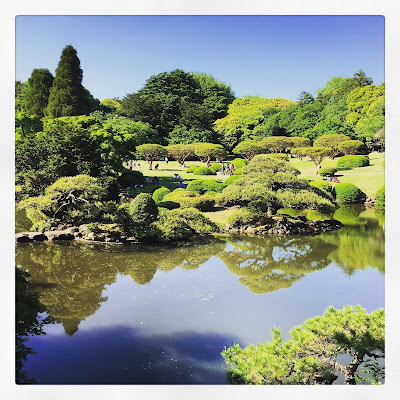Yesterday made me very tired with all these walking, so today I decided to take it slowlier. Besides, I need some oxygen! There's not much of it in my hotel (without any single window), and I guess not much on the streets of Tokyo.
The choice is easy - I will spend the day in one of Tokyo's parks, and actually in two of them. I decided to go first to Yoyogi Park where Tokyo's grandest Shinto shrine - Meiji-jingu - is located. There's a very easy access to it from my area (Tokyo Station), with JR 's Yamanote Line, comprised in my JR pass.
A Torii Gate at the entrance to the park
Meiji Shrine is Tokyo's most famous Shinto shrine. It was dedicated to Emperor Meiji - who was the first emperor of modern Japan - and his wife Empress Shoken. The shrine was destroyed during the Second World War, and rebuilt after, but it really looks very authentic. Slightly less crowded than the Senso-Ji temple, it made the visit much more pleasant and enjoyable. Some people wrote their wishes on little pieces of paper and tied them onto the prayer wall.
I'm lucky, today is a wedding day (although it's not Sunday) - I see a few couples who get married in the temple. The couples were followed by a procession composed of family and friends, together with Shinto priest leading the way.
Yoyogi Park is very pleasant, but what I miss there are benches. I wanted to sit down, relax and breath with a fresh air. Here it's impossible, therefore I head to the second park - Shinjuku Gyoen National Garden, which is in the close vicinity from Yoyogi. The entrance costs 200 Yen, but today is a green day, so nobody has to pay.
The park was originally the garden, created on the site of the private mansion belonging to Naito family in the Edo period. Completed at the beginning of 20th century as an imperial garden, after the the Second World War became a national garden and was opened to the public.
In the park there are 20 000 trees, including some of the first examples ever planted in Japan. Among these 20 000, there are apparently 1 500 cherry trees, unfortunately I came to Japan a few weeks too late in order to be able to admire them. Still, I love the garden, I enjoy the sun and my eyes with the beauty all around. The park comprises three distinct styles of garden - Japanese Traditional Garden, English Landscape Garden and French Formal Garden with dozens of species of roses.
Unfortunately Shinjuku Park is open only until 16:30, so I miss the greenhouse, which has a stock of over 1 700 tropical and subtropical plants.




















No comments:
Post a Comment